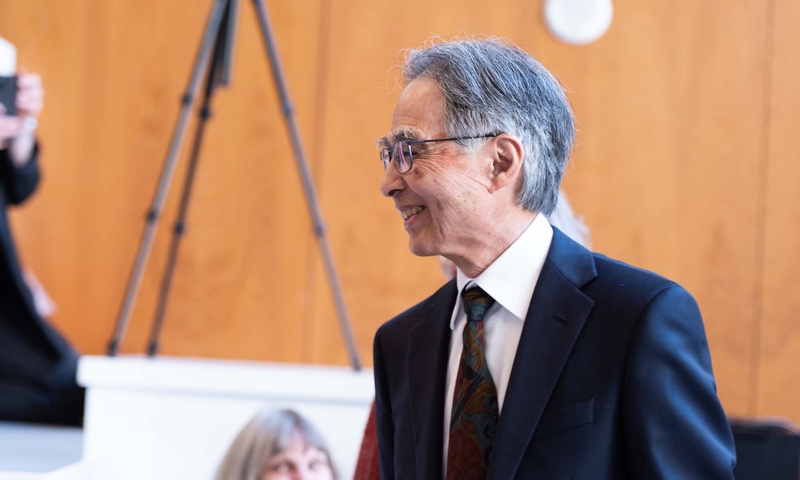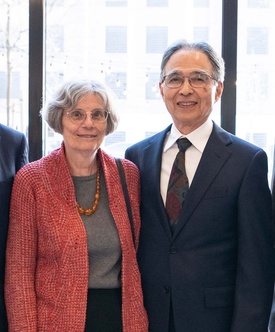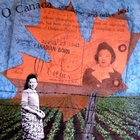Prior to 1995, Norman admits that he had little contact with the JC community: “My focus was on the local (Ottawa) art community and producing my own work and there appeared to be no one from the JC community who was part of this.”
He designed the 1977 poster for the JC Centennial based on Arthur Irizawa’s Centennial logo as the main image in the poster.” His first and only trip to Japan was in 1969-1970 to work on the Canadian Pavilion for Expo 70 in Osaka.
“The main impression I was left with was that it’s a very dense, crowded country full of interesting contrasts, old and new.”
Learning more about Japanese art, specifically woodblock printing, involved mining through resources.
“I spent a lot of time looking at the many books I have on traditional Japanese woodblock prints and basing a lot of my colours and images on these works. The more I studied these prints, the more I came to admire and respect these artists. The biggest challenge was in combining these woodblock images with my abstract forms so that they formed a complete composition. The main barrier I faced was questioning whether what I was doing was right. I decided it was acceptable.”
When viewing these works from a 60-plus year point of view, it’s important to consider how during those decades he was constantly searching for better ways to express himself and to improve his work.
“The biggest revelation I had was realizing that despite all the different paths I took trying to find my way, there was always an underlying consistency in my approach to image-making and that was very satisfying.”
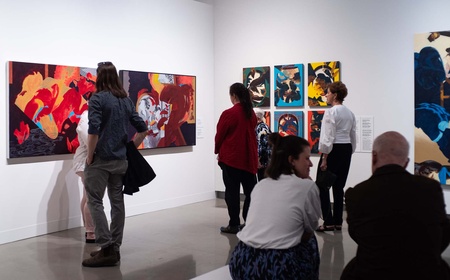
Sinclair explains that the show is broken up into six key themes:
“The show was designed to show six decades of Norman’s work all in one place, but the question is always, how to do this best?” she said.
“In the end, we decided not to organize it chronologically, but rather into six key themes: Abstraction, Conflict Work, Still Life, Graphic Art, Japanese Cultural Heritage, and Japanese Internment Legacy. In this way, the visitor can take in each section and see how Norman used similar themes or techniques over the years – essentially, each section contains its own mini chronology.
“We provided a chronological timeline at the start of the show so that visitors can orient themselves to the full story all at once, and began the show with the Abstraction section because abstraction is something that is really important to Norman and present throughout all of his work.”
Norman adds, “I would like visitors to see that despite the various paths I’ve taken and the themes I’ve dealt with over the years, there is an underlying consistency in how I’ve created my work.”
About “Abstraction,” he says: “I discovered abstract art in art school and became very drawn to it. The concept of creating something completely new, something that requires the challenge of creativity and invention is very appealing. Some form of abstraction is in almost everything I do. Does working in the abstract make it ‘easier’ to express some things?”
Conflict Work: “The work artists do is a reflection of life around us. We are witness to both the beauty and the ugliness in the world and it’s our job to reflect both. I choose to occasionally give thought to the darker side of the human condition when events become so disturbing that they cannot be ignored.”
Still Life: “Throughout my art career, I’ve enjoyed the challenge of depicting things that I see in front of me and doing it in a way that I would find interesting. It’s also a way to keep my hand and eye in shape. It’s a time-honoured practice.”
Graphic Art: “At art school, I divided my time between graphic design and painting, thinking I could make a living as a graphic designer. As much as I enjoyed the art of typography and illustration, I soon realized my heart was really in painting so that became my main focus. I still appreciate good graphic design.”
Japanese Cultural Heritage: “Because of my discomfort with being Japanese, my early work made no reference to my heritage. When I finally decided I needed to come to terms with being Japanese, I turned to my art and began incorporating Japanese images into my abstract compositions.”
Japanese Internment Legacy: “In rediscovering my Japanese heritage, I could not ignore the internment story.”
The social justice theme that runs throughout this exhibition goes back to the internment. “I would always be disturbed when people were treated unfairly. This has probably grown more intense as I grew older and became more aware of the wider world around me and the intolerance that exists in so many places. It seemed natural for me to make reference in my artwork to the things that were so disturbing to me. Racism has always been, and still is, both baffling and distressing.”

Sinclair points out: “I had no idea I would find the through-lines from the earliest works in the 1960s to today’s work that he’s creating. The theme of social justice, for example, is one that moves through his entire body of work; even though he was addressing it in the sense of global violence early on, such as the Civil Rights movement, and then ultimately it finds its place in his commentary on the Japanese Canadian Internment legacy.
“Artistic techniques derived from Pop Art, and Abstraction, and his knowledge of graphic design, are also used by Norman throughout the decades of his work. I loved seeing these traces throughout. I was also floored by his contributions to both Expo 67 and Expo 70. I’m a personal fan of mid-century modern design, and it was so exciting as Norman and Marion pulled out all the examples of his design work for those two important international expositions.”
Placing Norman into the larger context of the Canadian art scene, Sinclair says:
“Norman Takeuchi is an artist who has been able to make work that walks the line between being accessible and also conceptually rigorous. This isn’t an easy feat. Meaning, Norman’s work is very uniquely his own, yet it is very approachable and understandable for viewers. What was so interesting about looking at his work from the 1960s through to the current day is to see that he has had his own approach, and consistent techniques and references, throughout.
“He brings together techniques from Abstract Expressionism together with Pop Art, into unique conceptual collages that bring together seemingly disparate elements, from Ukiyo-e prints to archival images with his own abstract shapes in between. Hence the title of the show.
“Over the years, he has honed his initial training in the abstraction that was so prevalent in the 1960s, and used it in a very unique way that reflects his own struggle with his identity,” she continues: “Norman has also continued to apply his skill in graphic art throughout his compositions, and this comes out in his incredible understanding of colouration and line – his design aesthetic helps him to build very well resolved compositions that stand alongside the most current painting practices today. He is still prolific and working six decades later!”
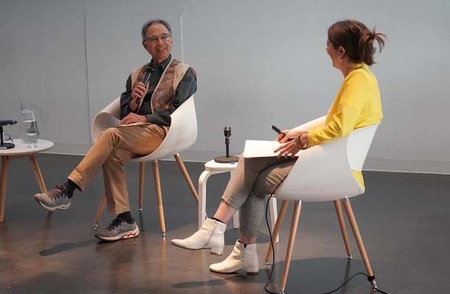
Norman admits that ‘legacy’ is something that he hasn’t given much thought to:
“It would be gratifying if some of the work I’ve done over the past 60-plus years lived on as part of Canadian art history. I believe the most important lesson I’ve learned is there is no substitute for hard work. The other lesson I would pass on is that if you want to learn new things in your work, it’s important to take risks and make mistakes in order to discover something new. For me, that’s what art is all about.”
Hamilton curator and artist Bryce Kanbara suggests that the place of Norman in the ongoing narrative of JC art is an important directional one for emerging generations.
Bryce writes: “For the many younger JC fourth-generation artists (Yonsei) who have begun to infuse into their artmaking long-unspoken stories of their families, accrued effects of intergenerational trauma, and the desire for communality, Takeuchi’s work is foundational, directional, and inspiring. At its core is an ethnocentric agenda…. Potentially, Japan is a looming legacy that we have been reluctant to fully acknowledge and accept. Takeuchi’s paintings are invitations. He points to a way back. He throws seeds and looks for an ancestral tree to grow.”
* * * * *
His wife, Marion, has constantly been by his side: “Ever since we were married in 1966, Marion has supported me in any way she could. Over the years, as my art career flourished, this support just increased to the point where she became the archivist, planner, accountant, gentle critic, and so much more. This all meant I was able to spend more time in the studio producing work. People remark on the amount of work I have produced and Marion is part of the reason.”
His parents and brothers deserve some credit too: “Thanks to my parents' strength and determination during the internment years, my younger brothers Ken (Vancouver) and Bob (Surrey, BC) and I have been able to live good lives, finding our own way in the world and, speaking for myself, enjoying the thrill of mounting a retrospective exhibition of my life’s work.”
Takeuchi’s father, Nawoki, was from Kochi prefecture and mother, Miyoko, was born in Vancouver. During World War Two the family stayed in the small Okanagan community of Westwold, BC along with some other Japanese Canadian families. After the war, they returned to Vancouver where his father reestablished his gardening business and mom set up a dress-making shop.
Still reeling from a “pretty lively” 2023, he says, “At the moment, I’m taking a break from the JC theme. I’m starting to feel I’ve taken it as far as I can without repeating myself and that’s something I don’t want to do. I’m almost certain though I will return to the theme once I figure out what else I want to say about it.”
And what is he working on now?
“I’m well into a new series of abstract paintings on paper with the colour palette being reduced to only two colours, black and red. This drastic change came about because I grew weary of the colours I was using and felt it was time for a change. And, as I said earlier, it was time to take a break from the JC theme and I’ve chosen to do that by returning to my abstract roots.”
Finally, he remarks:
“This retrospective came out of the blue and now that it has actually happened, it is the unexpected highlight of my art career. It also feels like a validation of all the work I’ve done over the past sixty-plus years when I’ve often wondered if what I’m doing is any good. And since I’m not quite finished, I can continue with more confidence than I‘ve had before. It’s a good feeling.”
© 2023 Norm Ibuki


